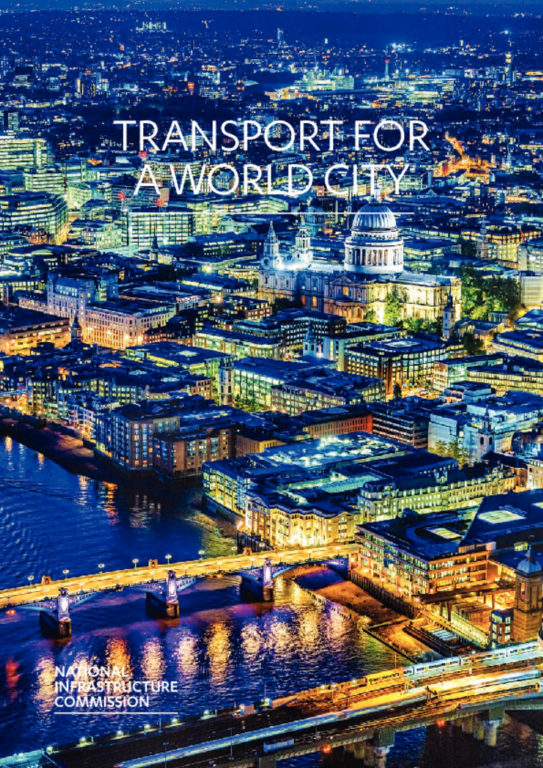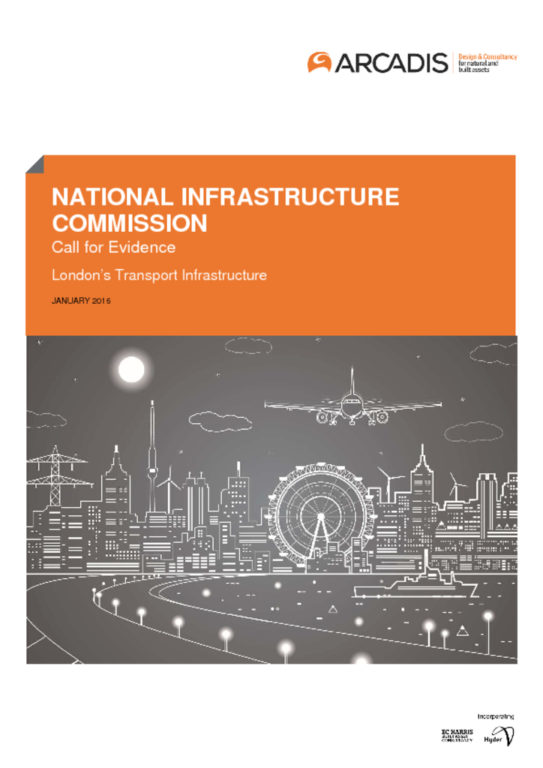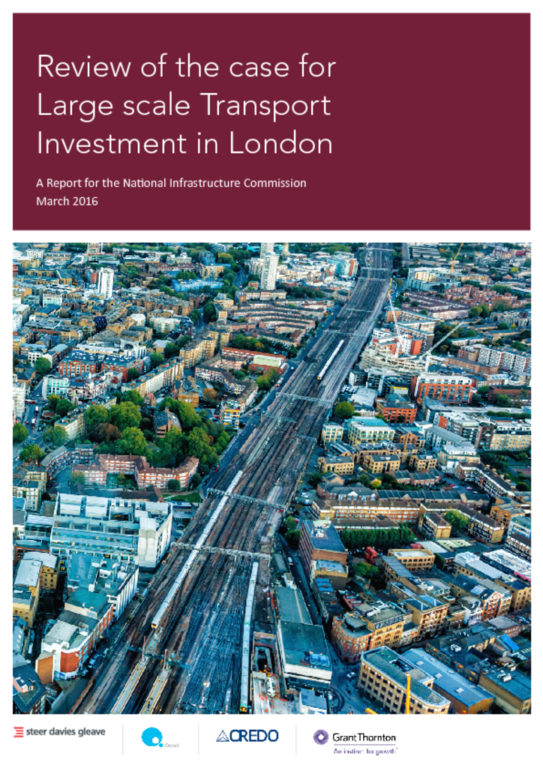Transport for a world city
The future need for large scale transport infrastructure in London and surrounding regions.
Summary
This study looks at the capital city's transport infrastructure and what is needed to ensure London remains a world-class economic hub. It concludes that Crossrail 2 should be taken forward as a priority by the government and the Mayor of London.
The Commission’s final report – Transport for a world city – concludes that, subject to the recommendations within the report, is that Crossrail 2 should be taken forward as a priority. Furthermore, funding should be made available to develop the scheme fully, with the aim of Crossrail 2 opening in 2033.
The final report makes a number of practical recommendations to deliver this outcome. First, sufficient development funds should be released for Transport for London (TfL) and the Department for Transport (DfT) to prepare a hybrid Bill for Crossrail 2, beginning with a revised business case.
Secondly, in developing that business case, it is crucial that Transport for London and the Department for Transport should identify clear proposals to maximise its benefits and increase deliverability of the scheme.
Recommendations
The report makes eight recommendations relating to the future transport needs of the capital city. The report recommendations were accepted in full by the government at the Budget in March 2016.
Crossrail 2 should be taken forward as a priority with the aim of opening in 2033, subject to the recommendations below.
Crossrail 2 should be at the heart of the new London Plan
Crossrail 2 should be at the heart of the new London Plan, alongside existing commitments to upgrades and other pieces of new infrastructure. Crossrail 2 should not, subject to affordability, prevent the development of other high value schemes, particularly where alternative funding mechanisms are available.
- London must continue to plan strategically for the period 2030-2050 through the next iteration of the London Plan. Crossrail 2 should be at the heart of this strategy and TfL’s wider programme of smaller scale interventions on the national rail, road, Underground and cycling networks in London should be integrated with it to complement and enhance its benefits.
- The London Plan should also include a detailed examination of the scope to deliver other strategic projects, such as further east London river crossings and the Bakerloo line extension, through alternative financing mechanisms. This should build on the precedents from the Silvertown Crossing and Northern line extension to Battersea/Nine Elms.
Submit a revised business case for Crossrail 2 by March 2017
Sufficient development funds should be released in order for TfL and DfT to submit a revised business case for Crossrail 2 by March 2017 and aim to introduce a hybrid bill by autumn 2019. The revised business case should include developed plans on costs, funding, housing and stations. TfL estimates the overall development cost at c.£160m, to which TfL should be expected to make a reasonable contribution.
Any proposal should maximise the benefits and increase deliverability of Crossrail 2
In developing the business case, it is crucial that TfL and DfT identify clear proposals to maximise its benefits and increase deliverability. The costs of Crossrail 2 are high and therefore every opportunity should be taken to improve its affordability.
The updated case should include detailed options to reduce and phase the costs of the scheme. The most promising option identified to enhance affordability would be to delay the construction of the northwestern branch to New Southgate. This could reduce the costs of the initial scheme in the 2020s by around £4 billion. More work should also be done on the costs and benefits of individual central London stations.
If construction of the north-western branch is delayed, this would also provide the opportunity to consider the case for an eastern branch from Hackney as an alternative.
A deal for funding should be agreed ahead of any hybrid Bill
A ‘London deal for Crossrail 2’ funding agreement, through which London contributes more than half the costs of the scheme and which includes substantial measures to realise the full housing benefits, should be agreed ahead of hybrid bill submission.
It is vital that a funding package for Crossrail 2 is developed which strikes a fair balance between the contributions made by London taxpayers and businesses and by central government. This should build on the work already undertaken by TfL, which indicated that around half the cost of the project could be funded from London sources.
The government should work with TfL and GLA to explore new funding options, which could include consideration of further devolution. However, even without such devolution, HM Treasury should be in a position to recoup significant receipts from the added Gross Value Added (GVA) benefits and the rising value of property in London.
A London deal for Crossrail 2 will need to cover both the funding of the project and the planning measures required to deliver Crossrail 2’s benefits.
A plan for 200,000 homes
TfL and DfT in conjunction with other government departments and relevant bodies, should use the next stage of development to set out a clear, transformative plan to turn the proposed 200,000 homes into a reality.
Strong measures to maximise the new housing enabled by the scheme should be included in the ‘London deal for Crossrail 2’–this could include the establishment of one or more development corporations to lead the masterplanning and delivery of new housing and urban realm provision, and revised planning guidance for the whole route. These measures should be considered as a potential model for improving housing deliverymore widely.
For housing provision to be a success across the whole route, the London deal for Crossrail 2 will need to have buy-in from the GLA and London boroughs along the route as well as counties and boroughs outside ofLondon which benefit from the new line. All parties will need to ensure the housing unlocked by Crossrail 2 is sustainable and meets the needs of Londoners and those in commuter regions around London.
Involve the private sector in development and funding of stations
The opportunity should be taken to maximise private sector involvement in the development and funding of stations and their surrounding areas.
TfL and DfT should leverage private sector capital and expertise to develop selected Crossrail 2 stations, including both the stations themselves and the surrounding land. Development could also be supported by land purchase powers and the ability to assemble sites.
Aim for a hybrid Bill by autumn 2019
Following the submission of a revised business case and agreement on the conditions above, the aim should be for a hybrid bill to be submitted by autumn 2019 – the first step towards the railway opening in 2033.
- Submission of a bill in 2019 would allow significant progress to be made on the passage of a bill before the end of this parliament.
- Completion of the project in 2033 would allow the project to open in time for the planned arrival of HS2 phase 2 at Euston.
Terms of reference
The terms of reference for this study were published by the government in October 2015. They were as follows:
The Commission’s review will be formed of two stages:
- first stage of work will require the Commission to review the evidence base and the strategic options for future investment in large scale transport infrastructure improvements in London – on road, rail and underground – including Crossrail 2
- in the second stage, the Commission will evaluate the available evidence and options identified through the first stage of its review and provide independent advice to government on the future large scale transport investment priorities in London
In taking forward this work, the Commission should engage with Transport for London, Network Rail and other relevant stakeholders.
The Commission should not through this study consider questions relating to airport capacity. The Davies Commission has already examined this issue in detail.
Stage 1: Establishing the evidence base and identifying the options available
The Commission will need to review and where necessary supplement the work undertaken to date by the Greater London Authority and Transport for London, in order to:
- review and prioritise the strategic transport challenges faced over the next 2-3 decades that could serve to constrain economic growth in London and the key corridor approaches into London
- consider the priority outcomes for future long-term transport infrastructure choices in the capital that best respond to those challenges – considering the relative importance of, and trade-offs between, capacity, reliability, journey times and connectivity to markets
- consider how existing long-term investment plans are successfully tackling the challenges and targeting the outcomes identified, and identify where there might be any gaps
- explore the main strategic options for future investment in large scale transport infrastructure improvements in London – on road, rail and underground – including Crossrail 2 – that could best address the future challenges
This should include Crossrail 2 but also consider a range of other strategic alternatives for large scale transport investment in London. For each option, the Commission should evaluate:
- strength of the strategic and economic case, based on a consistent appraisal methodology that is in line with the principles set out in the HM Treasury Green Book. It should also identify where there is a risk that an option or options may not pass a value for money threshold consistent with Spending Review 2015
- potential to increase benefits and reduce costs as far as possible, including through different interventions
- maturity of plans, including the extent of understanding about costs, benefits, scope, timetable and deliverability
- options for funding and financing in a way that minimises the tax payer burden, and ensures those that benefit most bear a fair share of the cost
The Commission should consider the potential impact of both Crossrail 2 and other strategic options for employment, productivity and housing supply in London and the South East.
As part of its review of the evidence base, the Commission should consider relevant international experience in major metropolitan areas, to review how other cities have responded to similar challenges and priorities, and whether there are any lessons to be learned and applied in London.
Stage 2: Independent recommendations on future investment priorities
In parallel, through the second stage of the review the Commission will conclude its work by providing government with a set of independent recommendations on future transport investment in London, including on Crossrail 2, based on an equal and balanced consideration of all available evidence and options. In providing this independent advice, the Commission should:
- stress test these recommendations under a range of affordability scenarios for the next 2-3 decades and highlight to government whether the conclusions of the review change materially under these different scenarios. The government will put forward, having consulted the Commission on the basis of its early work, three affordability scenarios that the Commission will use as the basis for its analysis
- highlight any major gaps in the evidence base. The Commission should clarify the extent to which these evidence gaps impact on its recommendations and future choices for government. Where relevant, the Commission should recommend further work that is required for government to make an informed choice
The Commission should report back to government with its recommendations on next steps by Budget 2016.
Supporting evidence
The study was supported by an open call for evidence and a review conducted by an expert panel.
Transport for a world city
The Commission’s report recommends a ‘Crossrail 2’ line for London be taken forward as a priority, as part of broader investment in the capital’s transport.

Latest Updates

Coming up in 2024
This page shows a calendar reflecting the latest expected dates for Commission reports, publications and events. You can also sign up to receive our quarterly newsletter by entering your email address in the box at the foot of each website page.

Transport for a world city: evidence submissions
The call for evidence informed the Commission's study on London's long term transport infrastructure needs.


